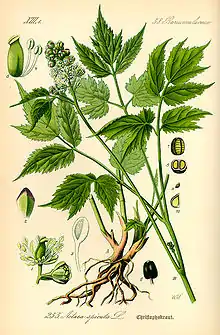Actaea spicata
Actaea spicata, the baneberry[4] or herb Christopher,[5] is a species of flowering plant in the genus Actaea, native from Europe to western Siberia and northern Iran.[3] It is often found on limestone edges and in deciduous woodland; key factors are shade, low competition, and a cool, protected root run.[6]
| Actaea spicata | |
|---|---|
 | |
| 19th century illustration | |
| Scientific classification | |
| Kingdom: | Plantae |
| Clade: | Tracheophytes |
| Clade: | Angiosperms |
| Clade: | Eudicots |
| Order: | Ranunculales |
| Family: | Ranunculaceae |
| Genus: | Actaea |
| Species: | A. spicata |
| Binomial name | |
| Actaea spicata | |
| Synonyms[3] | |
| |
Description
Actaea spicata is a herbaceous perennial plant growing up to 65 cm (2 ft 2 in) tall. The basal leaves are large, biternate or bipinnate. The leaflets are more-or-less toothed. The flowers are white, with 3–6 petaloid sepals, and are produced in an erect raceme. The fruit is a berry, black when ripe and 10–13 mm (0.4–0.5 in) across.[7][8]
Taxonomy

Actaea spicata was first described by Carl Linnaeus in 1753.[2] Two varieties have been recognized:[9]
- Actaea spicata var. spicata. Europe, northwestern Asia.
- Actaea spicata var. acuminata (syn. A. acuminata). Pakistan, India and the Himalayas, above 2000 m altitude.
Cultivation
Actaea spicata is cultivated as an ornamental plant. It is toxic by ingestion, and is also an irritant, so requires careful handling.[10] It has been used as a homeopathic remedy for arthritis and joint pain.[11]
References
- Schweizer, F. & Hasinger, O (2021). "Actaea spicata". IUCN Red List of Threatened Species. 2014: e.T202913A2757979.
{{cite journal}}: CS1 maint: multiple names: authors list (link) - "Actaea spicata L." International Plant Names Index (IPNI). Royal Botanic Gardens, Kew; Harvard University Herbaria & Libraries; Australian National Botanic Gardens. Retrieved 2021-02-22.
- "Actaea spicata L.", Plants of the World Online, Royal Botanic Gardens, Kew, retrieved 2021-03-26
- BSBI List 2007 (xls), Botanical Society of Britain and Ireland, archived from the original (xls) on 2015-06-26, retrieved 2021-02-21
- "Herb Christopher", Merriam-Webster.com Dictionary, retrieved 2021-02-22
- "Actaea spicata | Online Atlas of the British and Irish Flora". www.brc.ac.uk. Retrieved 2021-03-26.
- Stace, Clive A. (2019), New Flora of the British Isles (4th ed.), Middlewood Green, Suffolk: C & M Floristics, p. 106, ISBN 978-1-5272-2630-2
- Tutin, T.G. (1993), "Actaea", in Tutin, T.G.; Heywood, V.H.; Burges, N.A.; Valentine, D.H.; Walters, S.M. & Webb, D.A. (eds.), Flora Europaea, Volume 1: Lycopodiaceae to Platanaceae (2nd ed.), Cambridge University Press, p. 254, ISBN 0-521-41007-X
- Riedl, Harald & Nasir, Yasin J., "Actaea spicata", Flora of Pakistan (online), retrieved 2021-02-22
- "Actaea spicata". www.rhs.org. Royal Horticultural Society. Retrieved 17 February 2021.
- "DailyMed - ARTHRITIS AND JOINT RELIEF- actaea spicata, aesculus hippocastanum, arnica montana, bellis perennis, bryonia, calcarea carbonica, calcarea fluorica, causticum, cimicifuga racemosa, formicum acidum, hypericum perforatum, ledum palustre, lithium carbonicum, magnesia phosphorica, phytolacca decandra, pulsatilla, rhododendron chrysanthum, rhus toxicodendron, ruta graveolens, salicylicum acidum, sepia, zincum metallicum liquid". dailymed.nlm.nih.gov. Retrieved 2021-03-26.
- Flora Europaea: Actaea spicata
- Nepal Checklist: Actaea spicata var. acuminata
- "Actaea spicata". Germplasm Resources Information Network. Agricultural Research Service, United States Department of Agriculture.
- Plants for a Future: Actaea spicata
- Edible and Medicinal plants of the West, Gregory L. Tilford, ISBN 0-87842-359-1
